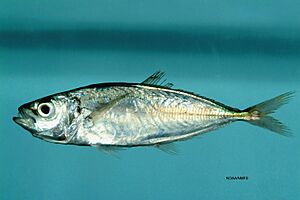Rough scad facts for kids
Trachurus lathami is a type of fish often called the rough scad or horse mackerel. It belongs to the Carangidae family, which includes many well-known fish like jacks and pompanos. You might also hear it called chinchard frappeur in French, chicharro garretón in Spanish, or jurel in Argentina and Uruguay. This fish lives in the western Atlantic Ocean, off the coasts of North and South America, and in the Gulf of Mexico.
Quick facts for kids Rough scad |
|
|---|---|
 |
|
| Conservation status | |
| Scientific classification | |
| Synonyms | |
|
Trachurus picturatus australis Nani, 1950 |
Contents
What Does the Rough Scad Look Like?
The rough scad can grow up to about 40 centimeters (about 16 inches) long, but most are around 30 centimeters (about 12 inches). It weighs up to 500 grams (about 1 pound). This fish becomes an adult when it's about 12 centimeters long.
Body Shape and Color
The rough scad has a long, slender body that is a bit flat on the sides. Its body is covered in thin, overlapping scales. The top of its body is blue, while its belly is silver and white. It has a black spot on the edge of its gill cover. Its nose, the edges of its top fin, and its tail fin have a dark tint. All its other fins are pale. The fish also has a large eye with an eyelid.
Where Do Rough Scads Live?
This ocean fish mostly lives in coastal waters. It can be found swimming in the middle of the water (this is called being pelagic) or near the ocean floor (this is called being demersal). Rough scads often live on continental shelves and near reefs.
Ocean Depths and Locations
You can find rough scads in ocean depths ranging from 30 to 200 meters (about 100 to 650 feet). They can sometimes be found in shallower waters if the conditions are good. For example, in 2009, some were seen in Mar Chiquita, a lagoon in Argentina. The rough scad's home range stretches from Canada all the way down to Argentina. It lives in the Gulf of Mexico, but it is not very common in the West Indies. Many rough scads are found off the coast of southern Brazil and near the Río de la Plata estuary between Argentina and Uruguay.
What Do Rough Scads Eat?
Rough scads eat many different things. Their diet mainly consists of small invertebrates. These include tiny crustaceans called copepods, euphausiid krill, and arrow worms. They also eat other small creatures like diastylid crustaceans, lucifer prawns, and even crab larvae and crustacean eggs.
Feeding Habits
Rough scads don't just eat invertebrates; they also eat other fish and their eggs. They seem to have a special feeding schedule, eating mostly in the afternoon and at night. This pattern is linked to their circadian rhythm, which is like their internal body clock.
How Do Rough Scads Live and Interact?
Rough scads often swim together in large groups called schools. This helps them stay safe from predators.
Staying Safe from Predators
Young rough scads sometimes hide near the jellyfish Chrysaora lactea. They can find protection by swimming under the jellyfish's bell or behind it. The jellyfish's tentacles can also help protect them. When they are not near the jellyfish, young scads can become food for other fish, like the comb grouper. Groupers are known to follow jellyfish, waiting for the scads to come out. The rough scad is also a major food source for many other animals, including the yellowtail amberjack (Seriola lalandi).
Rough Scads and Fishing
This type of fish is caught by commercial fishermen and is used as food for people.
Naming the Rough Scad
The scientific name Trachurus lathami was officially given to this fish in 1920 by a scientist named John Treadwell Nichols. He named it after Roy Latham, a farmer and naturalist from Long Island, New York, who helped collect the first samples of this fish.
Images for kids



